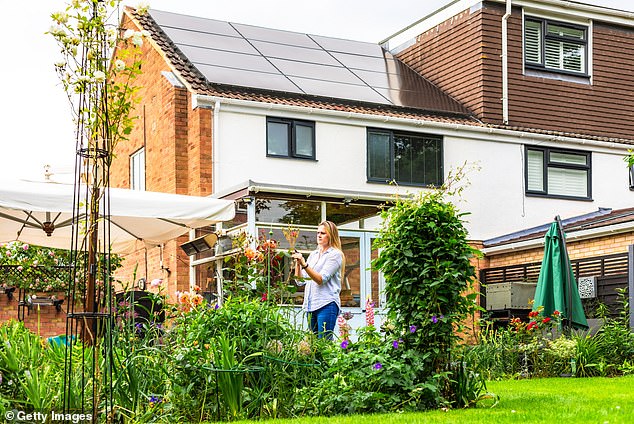Solar panel installations are booming – up 22 per cent in the first six months of the year, and there are now more than 1.8 million households with them.
But with panels costing thousands of pounds and most months in Britain struggling to match this summer's sunshine, will they save you money? Before signing up, there are some crucial things to consider to work out how long it will take for the cost to pay off.
Is your roof suitable?
The panels can be used to power your home, saving on your electricity bills. You can also be paid for exporting energy back to the grid, via a Smart Export Guarantee tariff.
The recipe for success requires your home to be suitable for them, with
the size of your roof and the direction it faces key. Your roof's size determines how many panels you can get, which will decide the potential output of your system.
A system's energy generation is measured in peak kilowatts (kW), with an average system for a three-bedroom house delivering 3.5kW, according to the Energy Saving Trust.

The amount of roof space required depends on the efficiency and potential output of the panels you get. For example, it could consist of ten 350 watt panels, covering about 20m2 of the roof.
Ideally, your roof will be south-facing. East or west-facing roofs will also work, but it is not recommended to install panels on a north-facing roof. A pitched roof is preferable, but a flat roof can work. Panels can also be installed on a shed or garage.
A system facing east or west generates 15 to 20 percent less energy than one facing south.
A 3.5 kW system in southern England could produce 3,000 kWh annually. This could be worth £560 a year, by saving £320 on bills and earning £240 from export payments.
How much will I earn?
The crucial calculation involves dividing the cost of the system by your annual return to see how many years it will take to pay it off.
You need to know: how much panels will cost, the energy you can generate, the estimated annual saving on your bills and the projected annual return from exporting.
For the three-bedroom example above, the panels would cost about £6,100, while the total annual return is £560, giving a pay back time of 11 years.
Returns will be influenced by some other factors. If you are at home all day, you can potentially save more on electricity bills by using power when it is generated.
On the flipside, this may mean you earn less from selling to the grid. Energy Saving Trust figures show how this and where you live can mean payback periods vary.
For someone in London who is at home all day, it would take ten years for solar panels to pay off, whereas if they were only at home after 6pm, it would take 12 years.
In Manchester, this would be 11 years and 13 years, respectively, while in Stirling it would be 12 years and 15 years and in Belfast 13 years and 21 years.
The Energy Saving Trust has a free solar panel calculator at pvfitcalculator.energysavingtrust.org.uk. Enter your address, along with property and household details, and it will tell you the cost, return and payback period.
Why are they so popular?
For early adopters, the environmentally friendly aspect of panels was a key driver, but now it is mostly about saving money and reducing exposure to volatile electricity costs. Installer Gareth Jones says his company, Carbon Zero Renewables, has seen a surge in requests since the energy price spike in 2022. He says: "You can take back an element of control with panels, otherwise you're at the mercy of energy companies."
How much will it cost me?
It depends on the size and type of system, how easy it is to access your roof and whether you need to do any other work on the roof.
While the Energy Saving Trust says the average domestic 3.5kW solar panel system costs around £6,100, others give higher figures. Which? says a 3kW system costs £7,020 to £11,250 to install, while a 5kW system is £11,650 to £16,300.
The exact figure will depend on the make and efficiency of your panels, as well as the cost of the installer, which varies across the country, but typically accounts for between ten and 20 per cent of the price.
Panels are now cheaper and more efficient as technology improves. Martin Aylward, of EDF UK, says: 'Domestic solar technology has come a long way in the past decade. A typical solar panel's power output has jumped from 250W to 450W and overall system peak production has increased from 3.5kW to 5.5kW in the past decade.' Installation costs have fallen by 4.5 per cent in the past year.
Batteries are an optional part of a system, but they can help homes save more money as they can store excess electricity to be drawn on when you need it.
A battery for a three-bedroom home costs £2,500. A replacement battery is usually needed after 15 years.
Are there any grants?
Low-income households receiving certain benefits, including Universal Credit, may be eligible for the Government's Energy Company Obligation 4 (ECO4), which covers up to 100 per cent of the installation cost. Go to: eco4.org.uk/
The Warm Homes Plan grants low-income tenants or homeowners and recipients of means-tested benefits up to £30,000 towards energy improvements including solar panel installations.
The government-backed Smart Export Guarantee (SEG) allows households to sell electricity they generate and do not use back to the grid.
Energy suppliers offer their own SEG tariffs, but to qualify, you'll need a smart meter and proof that your installation and installer are certified by the Microgeneration Certification Scheme (MCS).
0 comments:
Ikutan Komentar